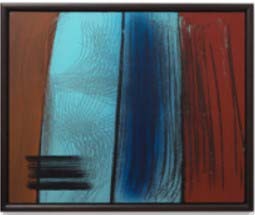Hans Hartung
T1971-H50, 1971
- Hans Hartung (°1904 , Germany)
- acrylic on canvas
- 81 x 100cm
A leading figure of the European Lyrical Abstraction movement, the German-French painter Hans Hartung is celebrated for his dramatic and experimental contribution to the field of 20th Century abstraction. His energetic compositions lie at the intersection of intuition and control, spontaneity and self-discipline, aesthetic and mathematics; ‘At the beginning, I act in total freedom. Work, by following its own course, constrains me more and more, and I am less and less at liberty to choose’. With the use of non-traditional tools, ranging from rakes, brooms, and olive branches to spray guns, and the application of innovative techniques, such as scratching, scraping and spraying, Hartung achieves his emblematic emotional abstraction. Long rhythmical brushstrokes, bold swirls, scribbles, and thatched lines rendered in a broad palette of limpid colours compose his singular visual language. Painted in 1971, T1971-H50 is a supreme example of the artist’s vigorous gestural freedom and graphic aesthetic. Layers of textures, lines and colours, scratched and painted using mud rakes and other instruments, intersect to create a spatially dynamic arrangement and to leave a record of the painter’s unique self-expression.
Born in Leipzig, Germany in 1904, Hartung studied philosophy and art history and attended art schools in Leipzig, Dresden, and Munich. After World War II, where he was severely wounded while being enlisted and imprisoned, he rose to become one of the representative figures of the New School of Paris. Hartung was the subject of a major retrospective at the Solomon R. Guggenheim Museum as early as 1953-1954, he participated in Kassel’s documenta in 1955, and he received numerous awards, such as the International Grand Prix for painting at the Venice Biennale in 1960. Hartung’s practice has had a profound influence on the development of American Abstract Expressionism and over subsequent generations of artists. His work is held in the collections of worldwide public institutions, including the Tate Gallery, London; The Museum of Modern Art, New York; the Metropolitan Museum of Art, New York; and the Museo Reina Sofía, Madrid, among others.
